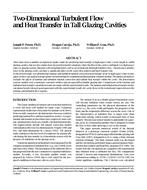Description
There have been a number of analytical studies made for predicting heat transfer in high aspect ratio (cavity height to width) glazing cavities, but very few studies have been performed for situations where the flow in the cavity is turbulent. For high aspect ratio (A) glazing cavities, buoyancy-driven turbulent flow will occur at moderate Rayleigh Numbers (RaL). The presence of turbulence in the glazing cavity can have a significant effect on the cavity flow pattern and heat transfer rate. In the present study, two-dimensional laminar and turbulent natural convection heat transfer of air in high aspect ratio rectangular cavities was analyzed using a finite-element turbulent computational fluid dynamic solution method. The numerical analysis includes the effects of laminar and turbulent natural convection and radiant heat transfer within the cavity. The fenestration systems studied were a prototype casement window and an argon-filled double-glazing unit. Comparisons of the laminar and turbulent heat transfer calculation results are made with the experimental results. The laminar and turbulent heat transfer model-calculated results showed good agreement with the experimental results for cavity flows in the transitional region between the laminar and turbulent flow regimes.
AUTHOR: Joseph P. Power, Ph.D., Dragan Curcija, Ph.D., William P. Goss, Ph.D.
CITATION: Thermal Performance of the Exterior Envelopes of Buildings VII
KEYWORDS: December, Florida, 1998
YEAR: 1998
Citation: Thermal Performance of the Exterior Envelopes of Buildings VII
Product Details
- Published:
- 1998
- File Size:
- 1 file , 210 KB
- Product Code(s):
- D-8083




